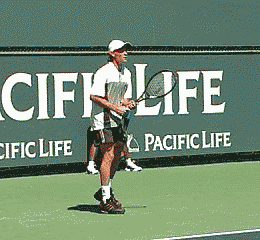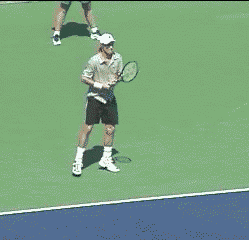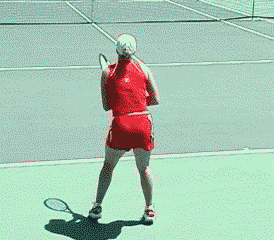|
TennisOne Lessons Are Your Feet Holding Back Your Strokes? Lee Taft It is such a common scene; a young tennis player missing a stroke and her coach barking "get your feet set before you hit the ball." The tennis player barks back I couldn't get there, and the coach sharply answers with a stern "Well, run faster"!
As a Sports Performance Coach specializing in Multi-directional speed, I hear this argument all the time between coach and player, no matter the sport. In tennis, it is ever so obvious if a player doesn't exhibit good foot speed and correct movement technique. Strokes, when the player is in position, are flawless, but lack of court speed makes the shot virtually impossible. Yet what do I see the next day in practice; more strokes from a ball machine and little to zero foot speed technique practice. It amazes me on how coaches and athletes neglect the one thing that can make all the tennis practice worthwhile, improving court speed and athleticism. I think one of the misconceptions of performing speed work is that it is the same as conditioning. In many cases young tennis players, or athletes from any sport, have a negative response when the term conditioning is brought up. I think much of this is due to overzealous coaches thinking more is better, not realizing they are programming an integral part of the sport as a negative and something the players want to avoid. It is extremely important to separate the two elements of sports performance so that tennis players realize that speed training is a skill and can be improved and must be practiced with focus! Let's take a look at some of the concepts that will drastically improve court speed for young and old tennis players.
Everything we do in life must start with a solid foundation. Tennis is certainly no different. In order for movement to be efficient and explosive the tennis player must have a great athletic stance (split step) or foundation. For the sport of tennis there are two basic athletic stances. The first is an active athletic stance which is recognizable by the active feet or bouncing action the player exhibits preparing for the ball to be returned by the opponent. The second athletic stance is known as a passive athletic stance which normally precedes the active athletic stance. The passive athletic stance is characterized by the feet being firmly planted on the ground with no bounding or stepping. Before we go any further I need to explain some simple points from a biomechanical and physics standpoint that will make the athletic stances efficient. • First of all, in order for a tennis player to push off there must be an appropriate angle by the foot and leg to produce force down and away from the intended direction of travel. For example; if a player wants to move out of the athletic stance or split step position to her right, the left leg will quickly apply force directly opposite the intended direction of travel. If this push off leg is too close under the hips the push off will cause what I call a "vertical lift" of the hips. This will take away from the first step speed. The key is to have the foot outside the hips far enough to push the body in the opposite direction, yet not so far that the athlete will slip.
The athletic stance, whether active or passive, should have the following characteristics:
Once the athlete understands these simple concepts they are able to move quickly to a stimulus. Once the tennis player reacts and moves from the split step or athletic stance there are a few more important concepts that must be understood to complete the acceleration to the ball. Let's take a closer look at these concepts:
The Crossover Step Although there are many other crucial techniques that will drastically improve the movement efficiency of a tennis player, to be discovered in future articles, the final technique that is going to be discussed is the Crossover. The Crossover is critical when moving laterally to a stroke, angular to a stroke, recovering for an offensive lob, or returning from a wide ground stroke back to the center of the court. Virtually anytime an athlete must run laterally out of a split step position or performing a series of crossovers as in recovering from a wide ground stroke; the hips must allow the legs to produce greater speed by opening up in the direction of travel. There are a few that must occur for the crossover step to be performed properly. Let's look at the following list to get a greater idea:
The important thing to remember is that the reaction, starting speed, and acceleration of the tennis player will greatly determine how well they can prepare to hit the ground stroke, or get to angles and drop shots. The crossover is a routine movement that is misunderstood. The greatest mistake is not getting the body into an acceleration position, during the crossover, to get to a spot on the court. Sometimes the acceleration position lasts only a couple steps or it may last up to seven or eight steps. As I mentioned earlier in this article, court speed is determined much by the biomechanics and physics that are applied. Just as if the ground stroke sails long because the racquet face had too much elevation at contact, the athletes' first step can be slow because the push off foot was too far under the hips and caused a vertical lift rather than a horizontal projection. Be efficient and be effective. In the future I will share with you one of the essential components that determines a tennis players true court speed and agility- Deceleration!! For now, have fun with your new techniques and enjoy your new court speed! Your comments are welcome. Let us know what you think about Lee Taft's article by emailing us here at TennisOne . |





